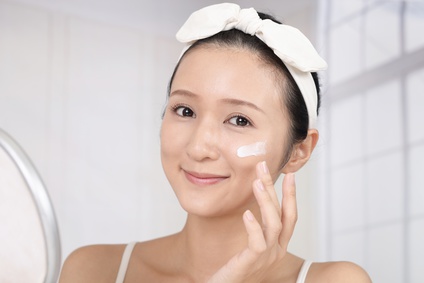

The skin has a natural tendency to retain a certain level of moisture. The skin barrier, the outer layer of the skin, plays an important role in keeping the skin hydrated. This may sound obvious now, but it was not known until the 1940s.
The basket-weave pattern of the stratum corneum is a type of an artefact resulting from microscope processing. In reality, the keratinocytes form a very tight and even bond with each other. The stratum corneum forms a strong protective barrier against infiltration of foreign substances and germs.
The Lipid Layer and Water Permeability
In the 1950s through the 60s, it was found that solvent-treated epidermis had drastically increased water permeability. This showed that lipids play an important role in the skin’s barrier function. Structural change of the lipids impact keratinocyte differentiation. Chromatographic analysis of lipids extracted from the stratum corneum found that the lipid layer was largely composed of ceramide (45-50%), cholesterol (25%), and free fatty acids (10-15%). Other types of fat made up 5% of this layer.
Intercellular Lipids
Lipids exist in the form of lipid sheets in the extracellular space of the epidermis. These lipids are not visible with regular optical microscopes. Fixing the specimen with ruthenium tetroxide allows visualization of the tight lipid layers in the extracellular space of the stratum corneum. Free fatty acids and fatty acids amide-bonded within ceramide have no covalent bonds. This allows direct and strong bonds to form gel phase membrane that is less flexible and permeable.
Cholesterol plays an important role in maintaining the flexibility of the cell membrane but in excess amounts, can lead the membrane to harden. Lamellar granules (LGs) in the granular layer are intracellular organelles that consist of phospholipid, cholesterol, and glycosylceramide. LGs exit the cells during epidermal differentiation. Acid hydrolase breaks phospholipid and converts glycosylceramide into ceramide.
[Advertisement] FCR® (Fractional Prickle CoralCalcium Regentron) – Manufacturer: (www.illglobal.com)]
During lipid metabolism, following enzymes play a role; acid sphingomyelinase, and secretory phospholipase A2. Lysosomal acid lipase also exist in the LGs and impact keratin turnover through protease moderate desmosome degradation. Various lipids within the LGs come out of the cells to form lamellar sheets. Lipid stack is held together by edge-to-edge fusion and Ca2+ plays an important role in this process.
The only lipid that keratinizes the epidermis is acyl glucosylceramide (AcylGlcCer), created from an ester bond between a very long ω-hydroxy fatty acid moiety (C28-36) and linoleic acid. At the Golgi membrane, acylceramide is glucosylated and bonds to linoleic acid. The fatty acid chain that attaches in the back is elongated enough to completely pass the lipid bilayers and connect to the nearby lipid layer.
-To be continued




















